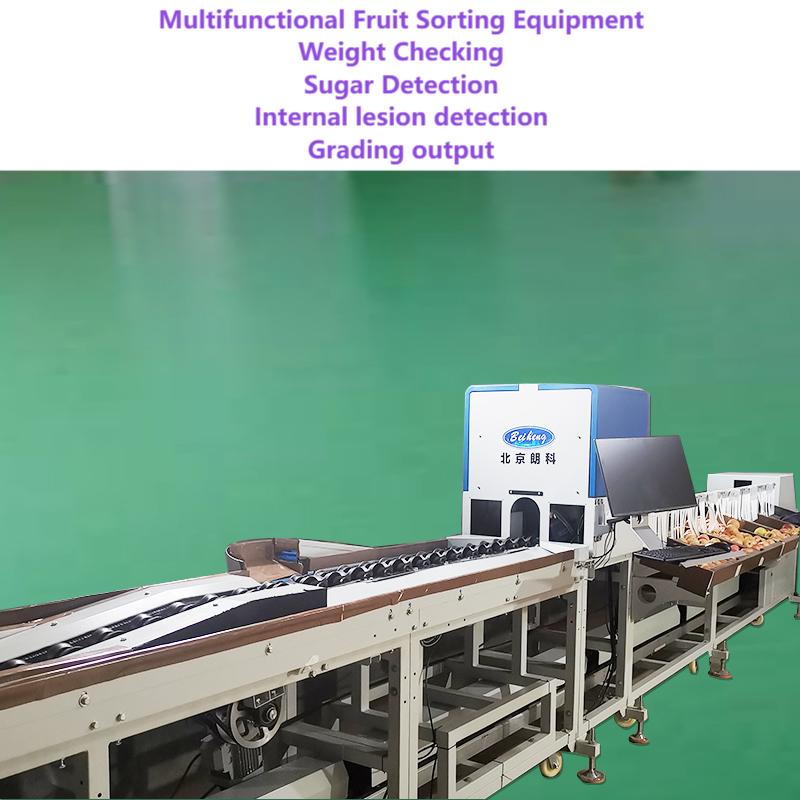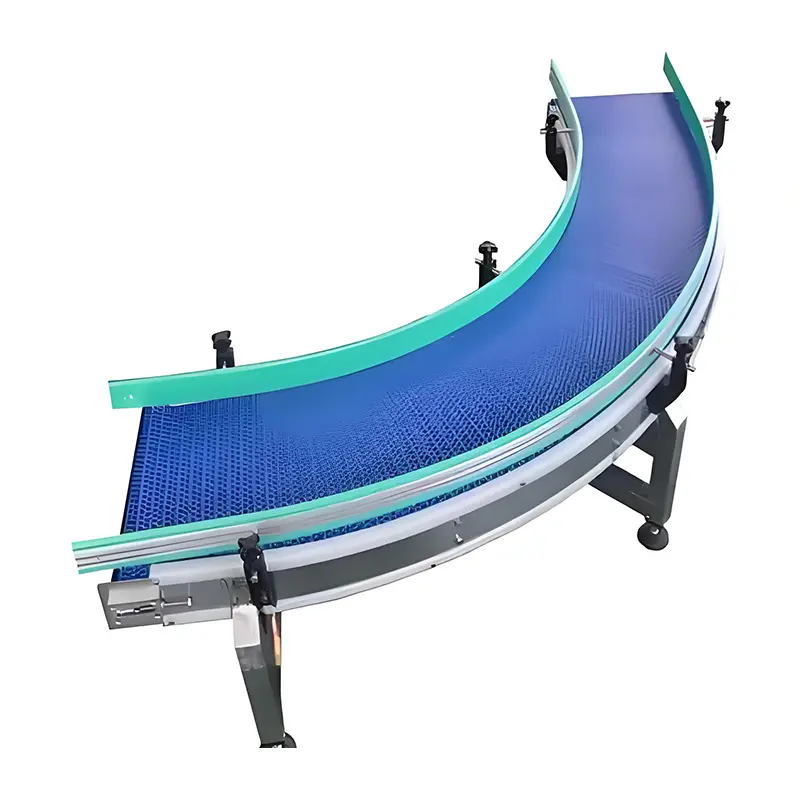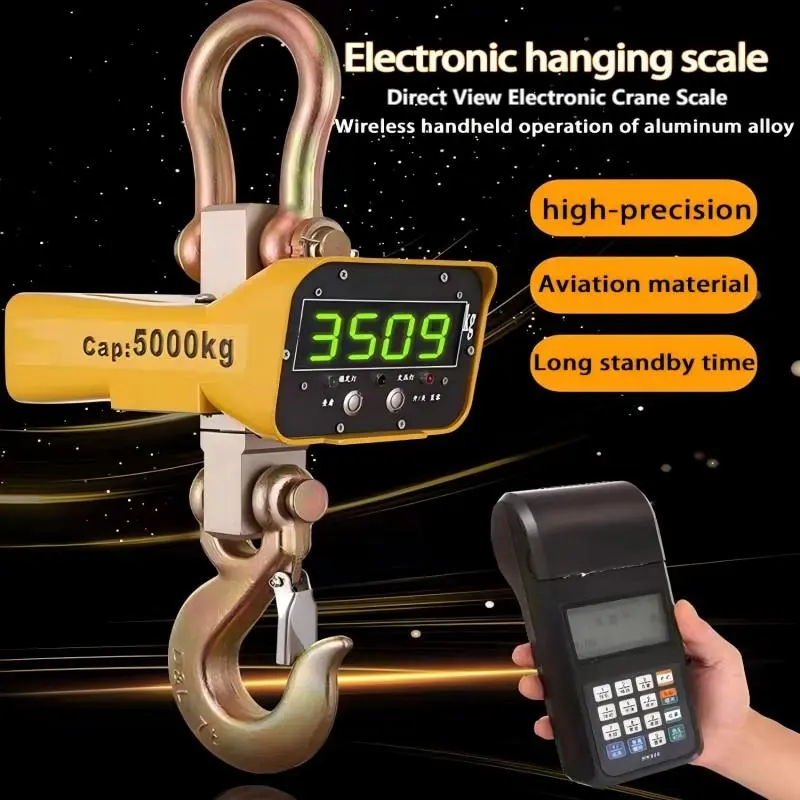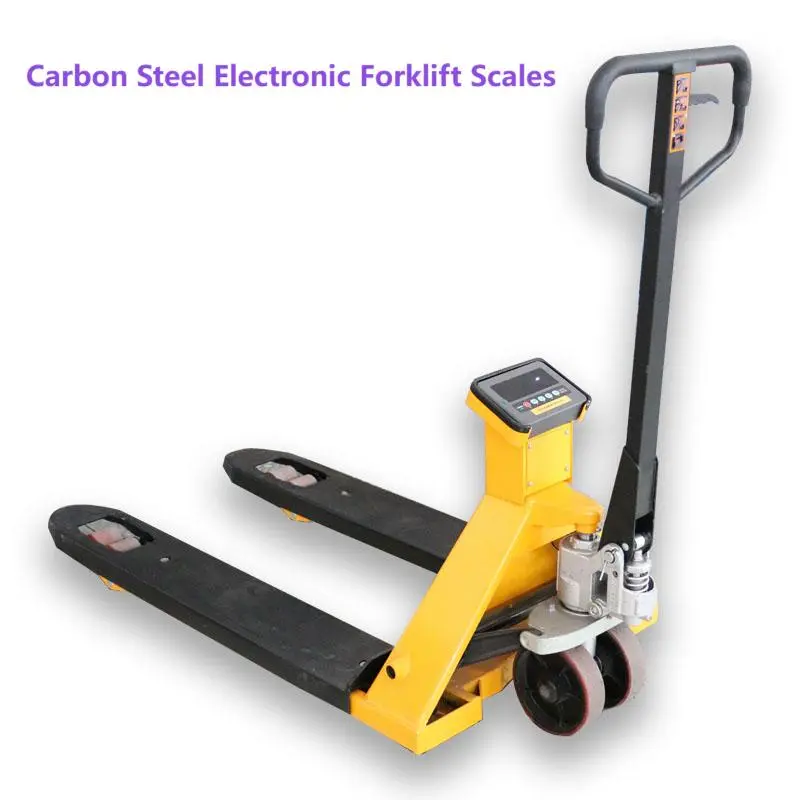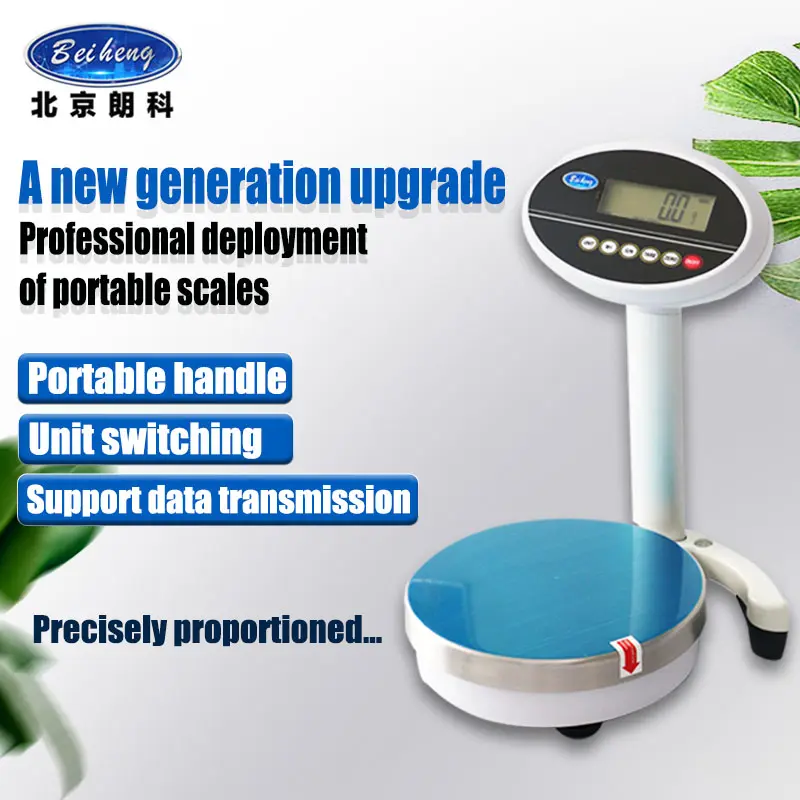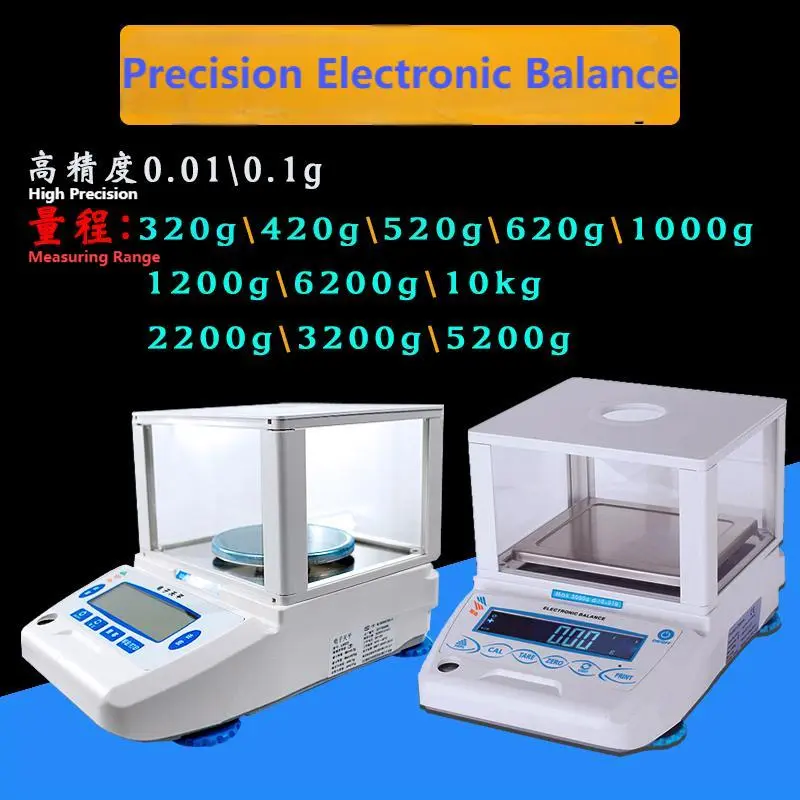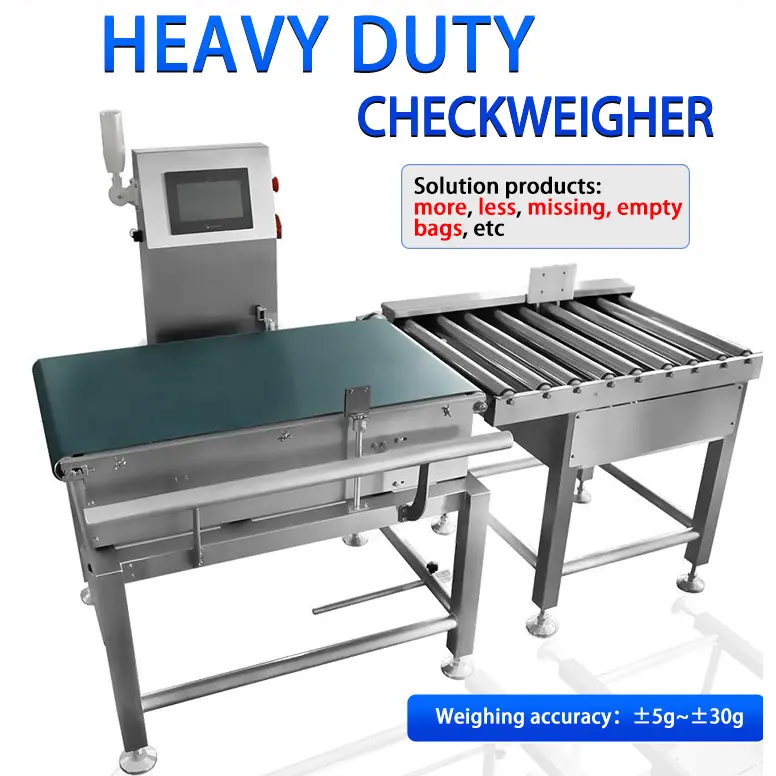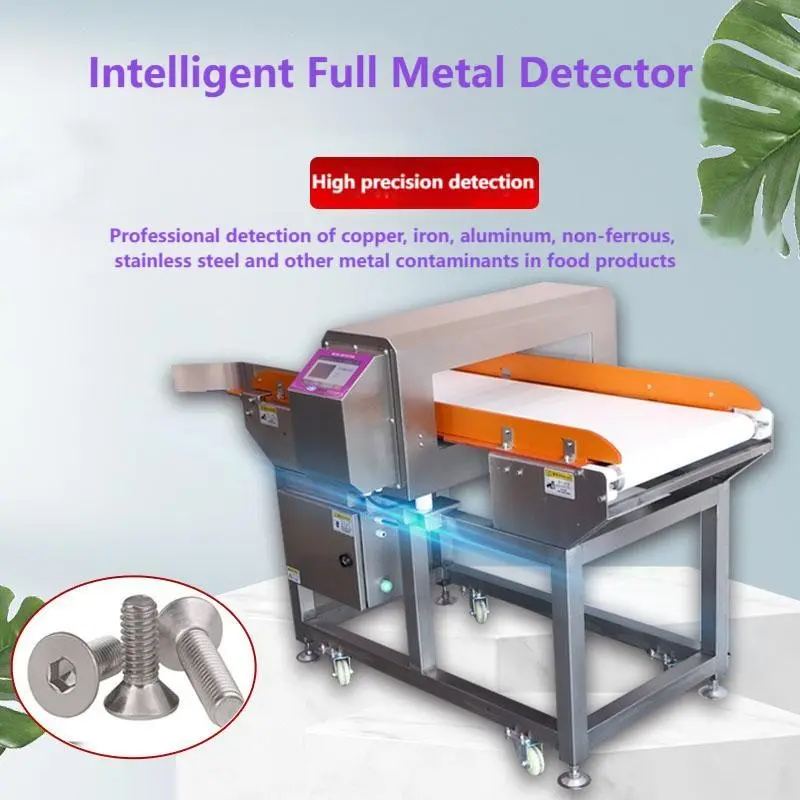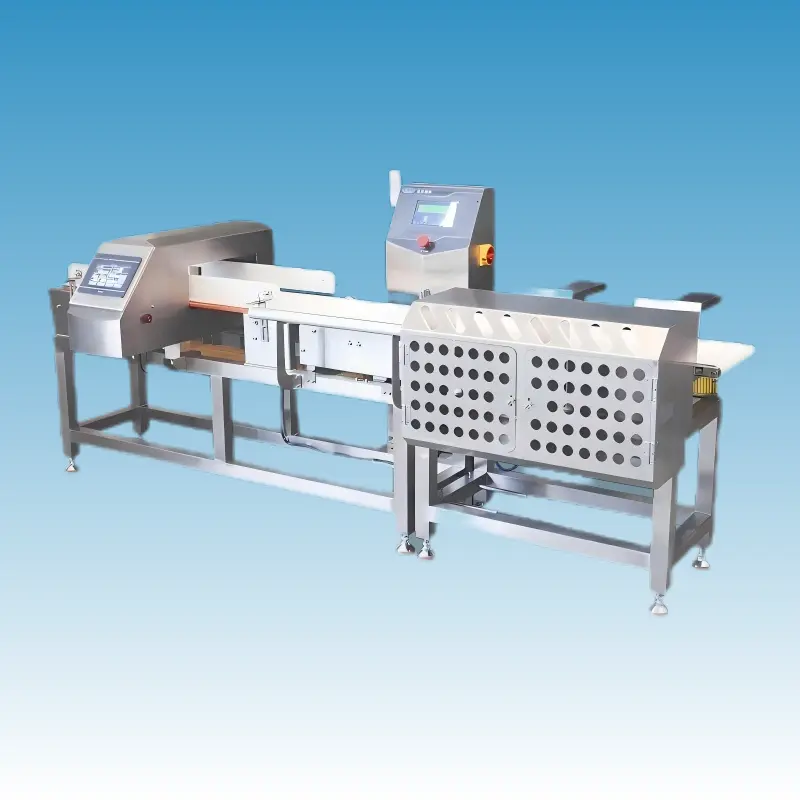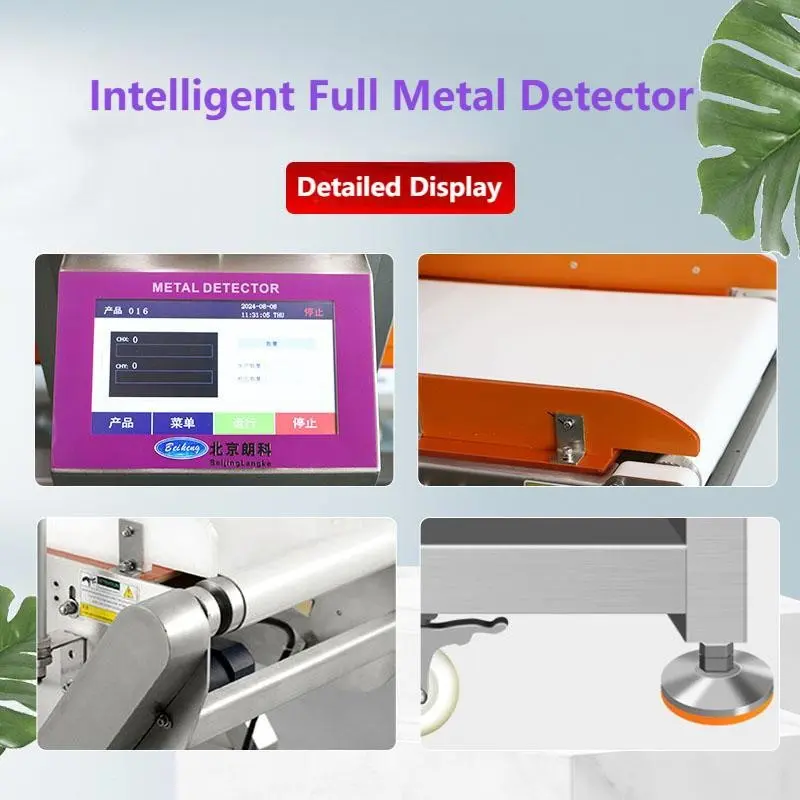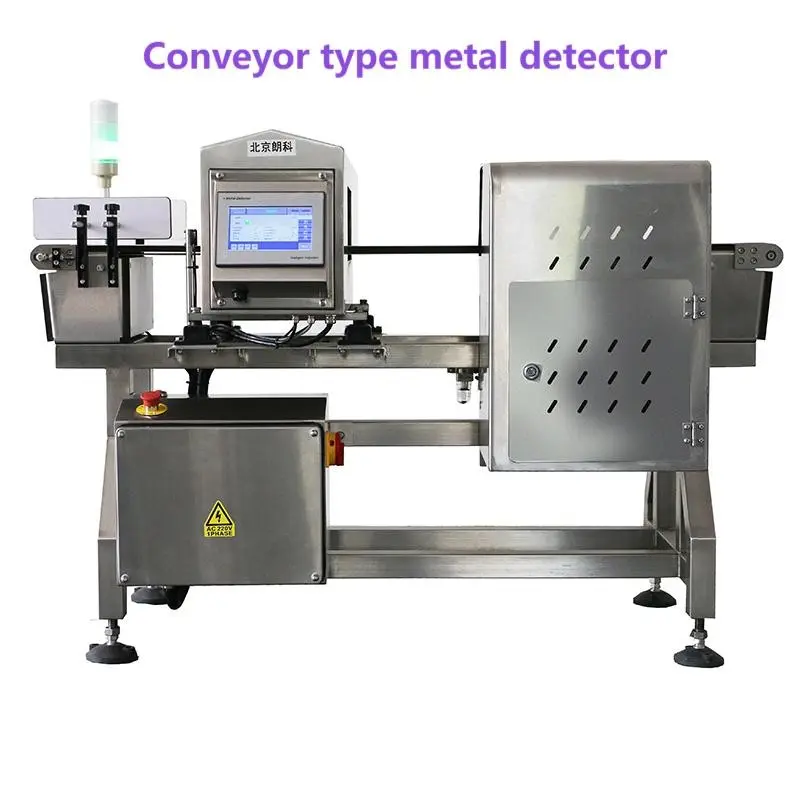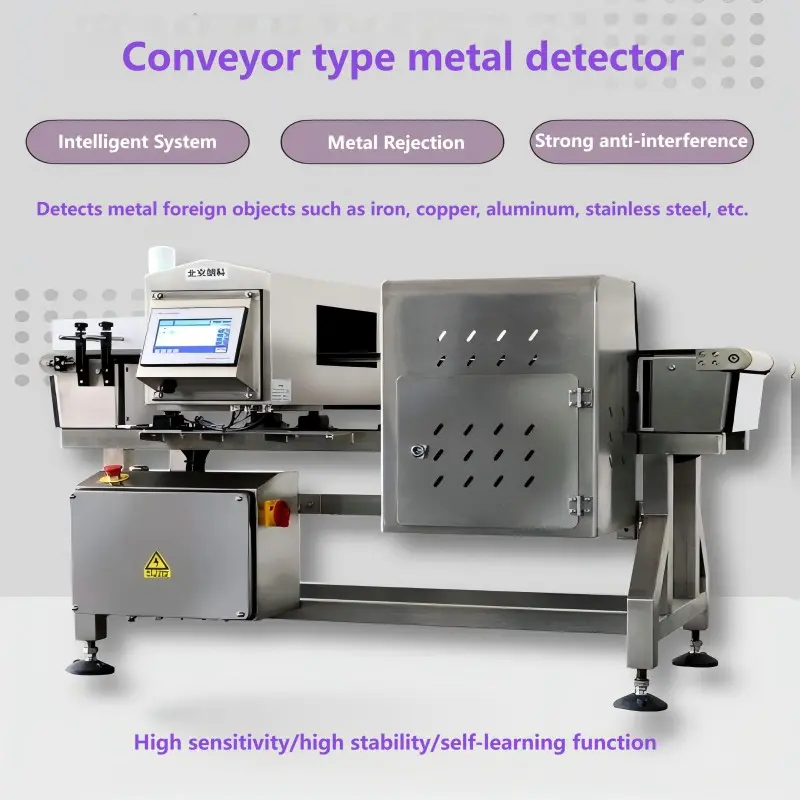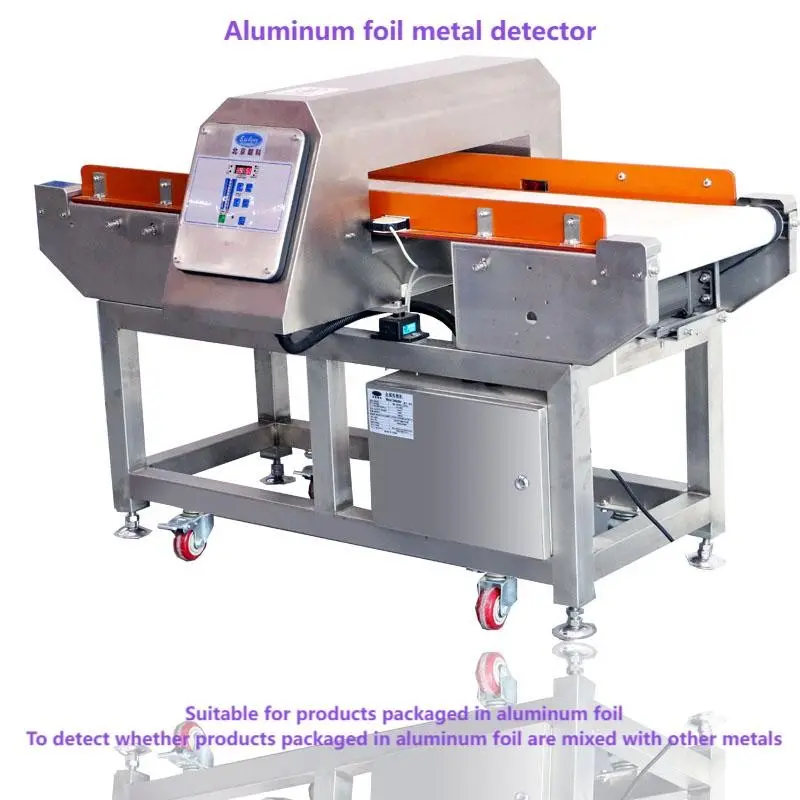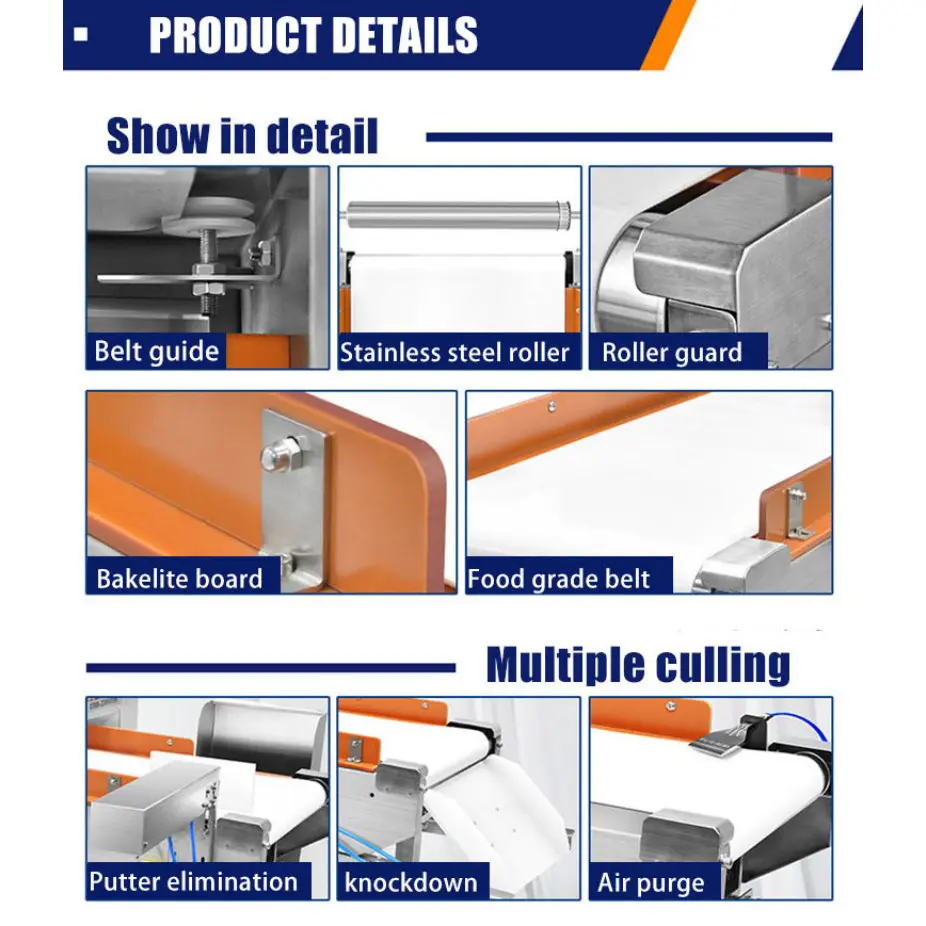Beiheng High Quality Conveyor Belt Metal Detector Machine for Food Industry Line
Video
Product Classification
一. According to the detected items transport mode classification
1. Channel metal detector
Characteristics: the detector channel is square, generally equipped with a conveyor belt mechanism, with automatic rejection device or provide alarm signals.
Application: mainly used for finished and semi-finished products online detection, to provide the final inspection before shipment, such as bagged materials, boxed products.
Classification: Split channel metal detector (easy to install, especially for large equipment) and integrated channel metal detector.
2. Falling metal detector
Characteristics: usually equipped with automatic rejection device, mainly used for tablets, capsules, granular (such as plastic particles), powdered goods detection.
Application: When these items fall through the falling metal detector, once detected metal impurities, the system immediately start the separation mechanism to exclude suspicious items.
Advantage: Easy installation, high sensitivity, easy maintenance, high efficiency, stability and reliability.
3. Pipeline metal detector
Features: capable of real-time online removal of metal impurities, to ensure that the product is safely transported to the next process.
Application: Mainly used for the detection of liquid products, such as ham sausage meat sauce, chewing gum, oral fluid, sauces, and so on.
二. According to the application scene classification
1. Conveyor type metal detector
Features: mainly used for detecting smaller products, suitable for production lines.
2. Handheld metal detector
Features: Portable, easy to operate.
Application: Early in the docks, airports, workshops and other places for public safety inspections, and now mainly used in examination centers to prevent candidates from cheating.
3. Vacuum conveyor metal detector
Application: Mainly used in chemical industry to detect products with high environmental requirements.
4. Pressure Conveying Metal Detector
Application: mainly used in food, spice and other industries to detect liquid or viscous products.
5. Underground metal detector
Features: Early in the military for the detection of minesweeper, now mainly used for the detection of metal materials.
三. According to the functional classification
1. All-metal detection machine
Features: can detect all metals such as iron, stainless steel, copper, aluminum, etc., detection accuracy and sensitivity are relatively high, stable and reliable.
2. Ferrous metal detection machine
Features: can only detect ferrous metal, commonly known as needle detection machine, detection accuracy and sensitivity is lower, easy to interfere.
3. Aluminum foil metal detector
Features: also can only detect ferrous metal, but in the detection of products with aluminum foil packaging, its detection accuracy and sensitivity is still high.
Img
-
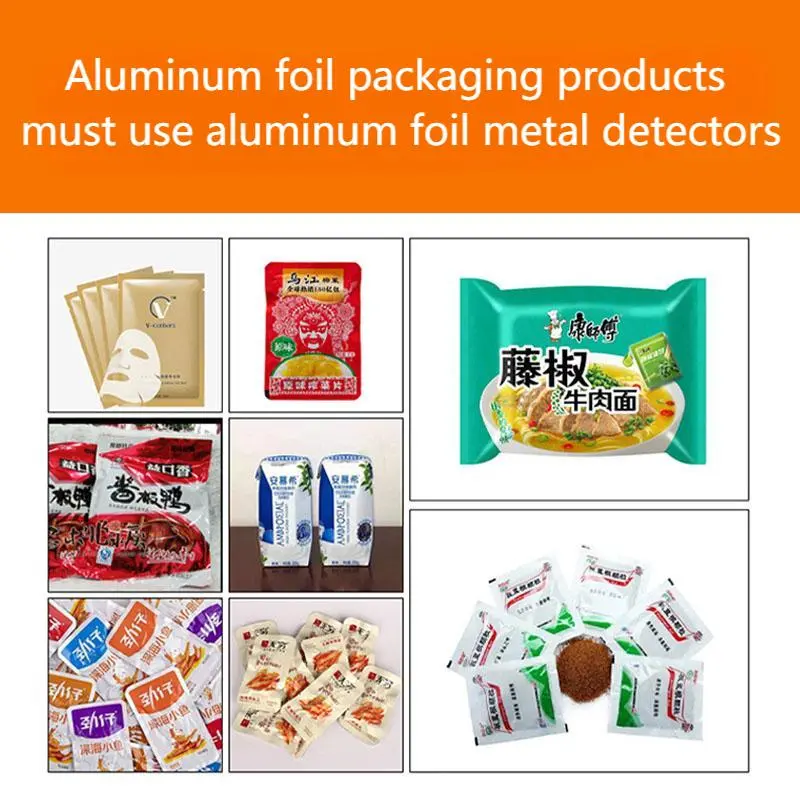
Product Classification-va
-
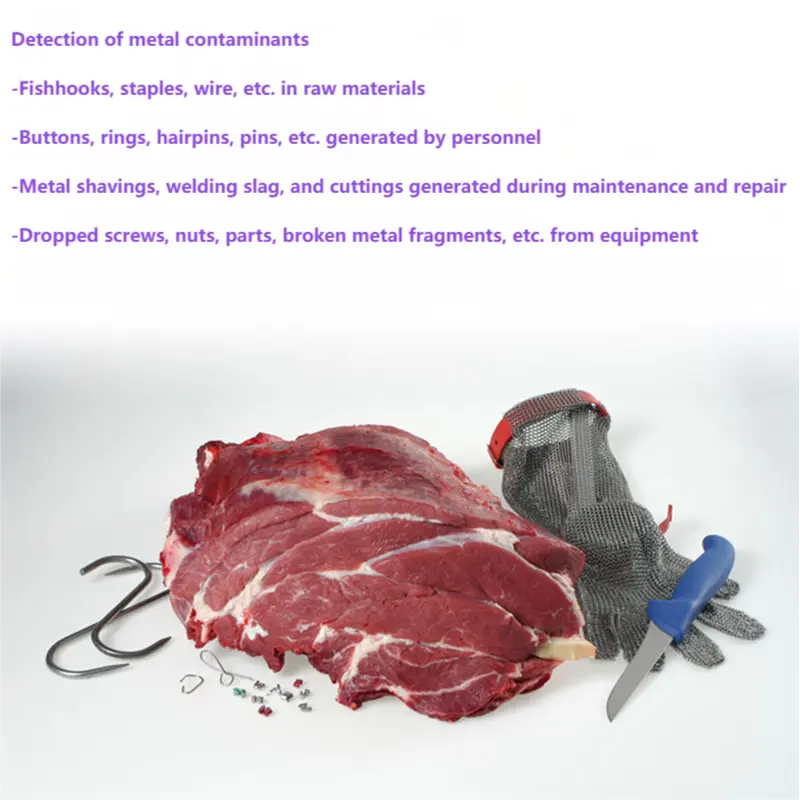
Product Classification-vsd
-
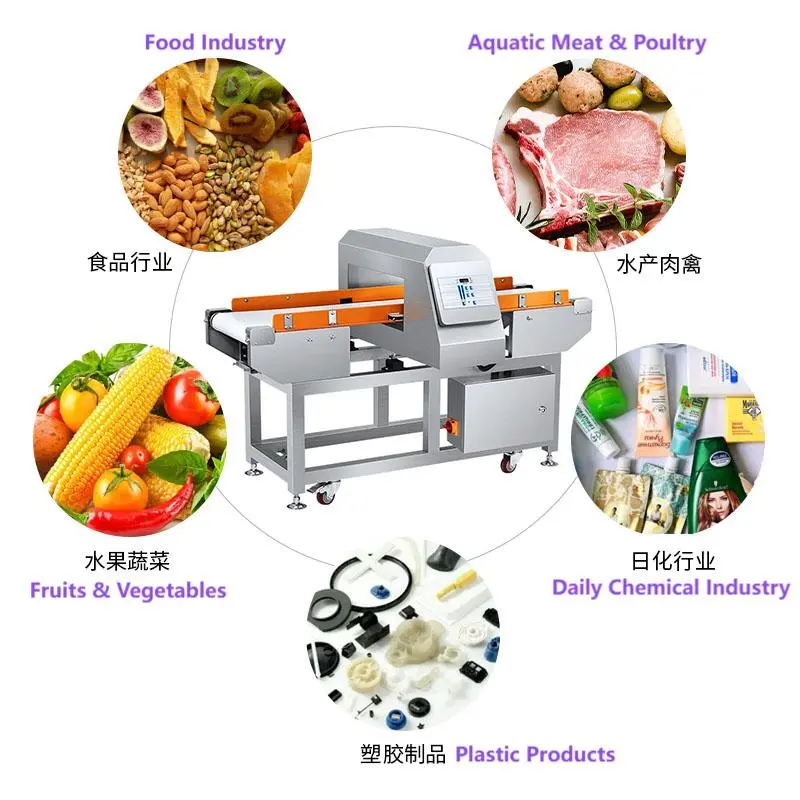
Product Classification-ve
Operating Principle
The metal detector detects the presence of metal contaminants in the product by receiving signal changes in the sensor or coil. Its detection principle is based on electromagnetic induction and signal processing technology, which can efficiently detect metal contaminants in the production line to ensure product quality and safety.
1. Core Components and Magnetic Field Generation
The core component inside the device usually consists of a central transmitting coil and two equal receiving coils, which are carefully assembled into a detector head. An oscillator emits a high-frequency magnetic field through the central transmitting coil, which is the basis of the detection process. The two receiving coils are connected to the transmitting coil, but have opposite polarity.
2. Magnetic Field Equilibrium
In the absence of any external disturbance to the magnetic field, the voltage output signals generated by the two receiving coils cancel each other out to reach an equilibrium state. This equilibrium state is not affected by temperature change, vibration, electromagnetic interference and other external environment.
3. Metal contamination interference and signal changes
When the product to be detected (such as food, medicine, etc.) passes through the metal detector, if the product contains metal contaminants, these metal contaminants will enter the magnetic field area. Since metal is an electrical conductor, it causes a change in the initial electromagnetic field, which in turn affects the electrical signal in the receiver coil. The receiving coil continuously monitors the changes in the electromagnetic field and converts these changes into electrical signals.
4. Signal analysis and processing
These electrical signals are fed into the electronic system within the metal detector for analysis. The electronic system compares the characteristics of these electrical signals (e.g., amplitude, frequency, etc.) with preset thresholds or criteria to determine the presence or absence of metal contaminants. If the change in the electrical signals exceeds the preset threshold, the metal detector triggers an alarm to notify the operator or the system.
5. Alarm and Rejection
An alarm signal is triggered when a metal foreign object is detected. At the same time, the system can use the alarm signal to control the automatic rejection device, etc., so as to exclude the metal contaminants from the production line and ensure the purity and safety of the products.
6. The technical characteristics and influencing factors
High sensitivity: it can detect tiny metal contaminants thanks to its advanced electromagnetic induction technology and signal processing technology.
Strong adaptability: it can adapt to different shapes, sizes and types of metal contaminant detection, and at the same time can cope with a variety of complex environments and product characteristics.
Influencing factors: Its detection sensitivity can be affected by a variety of factors, such as the type, shape, size and burial depth of the metal, as well as the influence of the product itself (e.g. conductivity, density, thickness of the product, etc.) and the interference of the environment (e.g. temperature, humidity, electromagnetic field, etc.).
-

Operating Principle-va
-
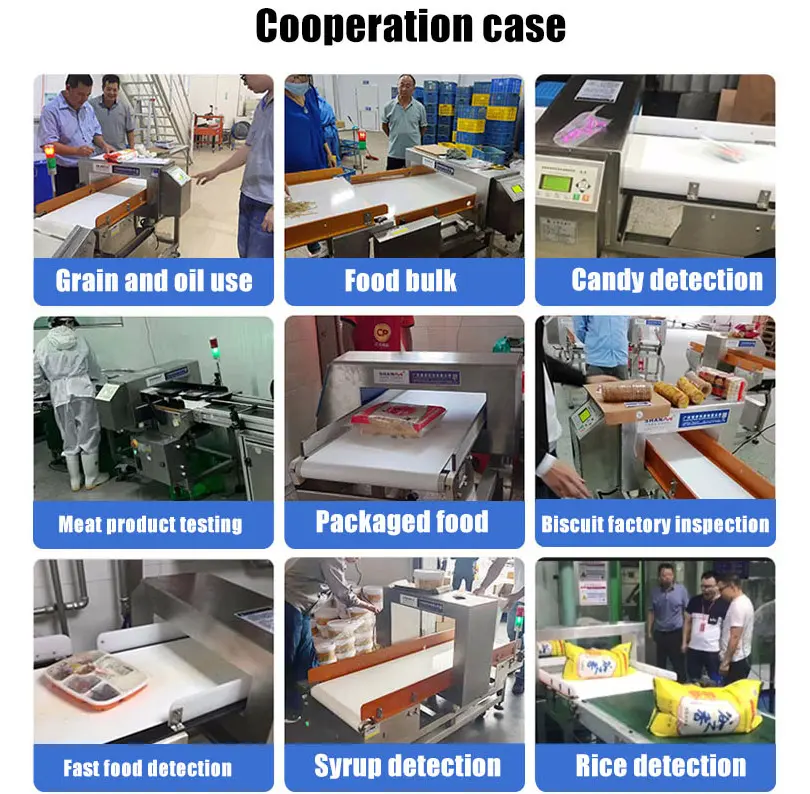
Operating Principle-bg
-
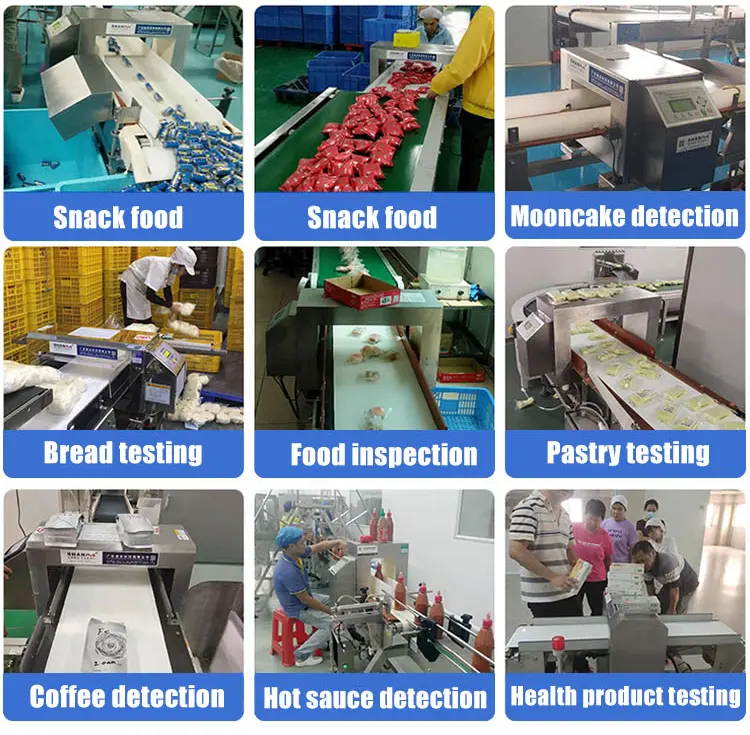
Operating Principle-wa
Detection Sensitivity
The detection sensitivity of a metal detector is a complex and critical performance indicator that is affected by a variety of factors and reflects the ability of a metal detector to detect metallic contaminants in a complex environment. The exact value of sensitivity will vary depending on the model, make and design of the metal detector and the characteristics of the item being detected. When selecting and using metal detectors, it is necessary to consider these factors and take appropriate measures to improve sensitivity to ensure the accuracy and reliability of detection results.
一. The definition and expression of sensitivity
The sensitivity of a metal detector is usually expressed as the minimum size or quality of metal contaminant that it can detect. For example, a metal detector may have a sensitivity of 1.0 mm, which means that it is capable of detecting metal contaminants with a diameter or equivalent size of 1.0 mm. Sensitivity can also be expressed in other ways, such as the mass of metal contaminant that can be detected or a specific type of metal.
二. The factors that affect sensitivity
1. The metal detector itself factors:
Opening size: The opening size (window size) of the metal detector will affect its sensitivity. Generally speaking, the smaller the aperture size, the higher the detection accuracy, because a smaller window can reduce the interference from the environment and improve the detection accuracy. However, a window that is too small may result in missed detections because some metal contaminants may be at the edge of the detection area and go undetected.
Frequency: The operating frequency of a metal detector also affects its sensitivity. Generally, the higher the frequency, the higher the sensitivity. However, it should be noted that too high a frequency may increase the risk of false rejection rate.
2. Metal foreign object factors:
Metal shape and size: The shape and size of the metal contaminant directly affects the ease with which it can be detected. In general, the larger the metal, the easier it is to detect; the smaller the metal, the less likely it is to be detected. In addition, non-spherical metal particles (such as metal shavings or wire) are more easily detected if they pass through a metal detector in one direction rather than another, which is called the "directional effect.
Type of Metal: Metals are generally classified as ferrous, nonferrous or stainless steel. The ease with which different metals can be detected depends on the permeability of the metal contaminant (i.e., how easily it can be magnetized) as well as its electrical conductivity. In dry product applications, all metallic contaminants are relatively easy to detect, while in wet product applications they are relatively difficult to detect.
Metal Location: The location of a metal contaminant within the detection zone also affects how easily it can be detected. The sensitivity of the metal detector in the opening of different positions will be different, usually the geometric center is the least sensitive parts, and near the wall of the metal detector at the strongest sensitivity.
3. Product factors:
Product packaging: If the product packaging material itself is electrically conductive (such as aluminum foil packaging), then this packaging material will greatly affect the detection sensitivity. For packaging materials with conductivity, it is recommended to perform metal detection before packaging.
Product characteristics: The water and salt content of the product can also affect the sensitivity of the metal detector. Wet products (e.g. fresh meat, cheese, fish, etc.) or products with a high salt content (e.g. seafood) create a "product effect signal" in the metal detector and are therefore relatively difficult to detect.
Product Speed: The metal detector has certain limitations on the conveyor speed of the product being detected. If the conveyor speed exceeds a reasonable range, the sensitivity of the detector will be reduced.
4. Environmental factors:
Environmental temperature, humidity, electromagnetic interference and other factors may affect the performance of the metal detector. In order to achieve the best metal detection results, the aperture of the metal detector should be surrounded by a region known as "free metal zone", this region should be far away from any metal.
三. To improve the sensitivity of the measures
1. Select the appropriate metal detector model and specifications to adapt to the characteristics and needs of the detected items.
2. According to the size and shape of the detected items as well as detection requirements and scenes to choose the appropriate window size.
3. Maintain and calibrate the metal detector regularly to ensure the stability of its performance and sensitivity.
4. Pre-process the items appropriately before detection, such as removing packaging, adjusting the speed of items conveyed.
5. Maintain a stable detection environment to avoid the influence of factors such as ambient temperature, humidity and electromagnetic interference on the detection results.
-
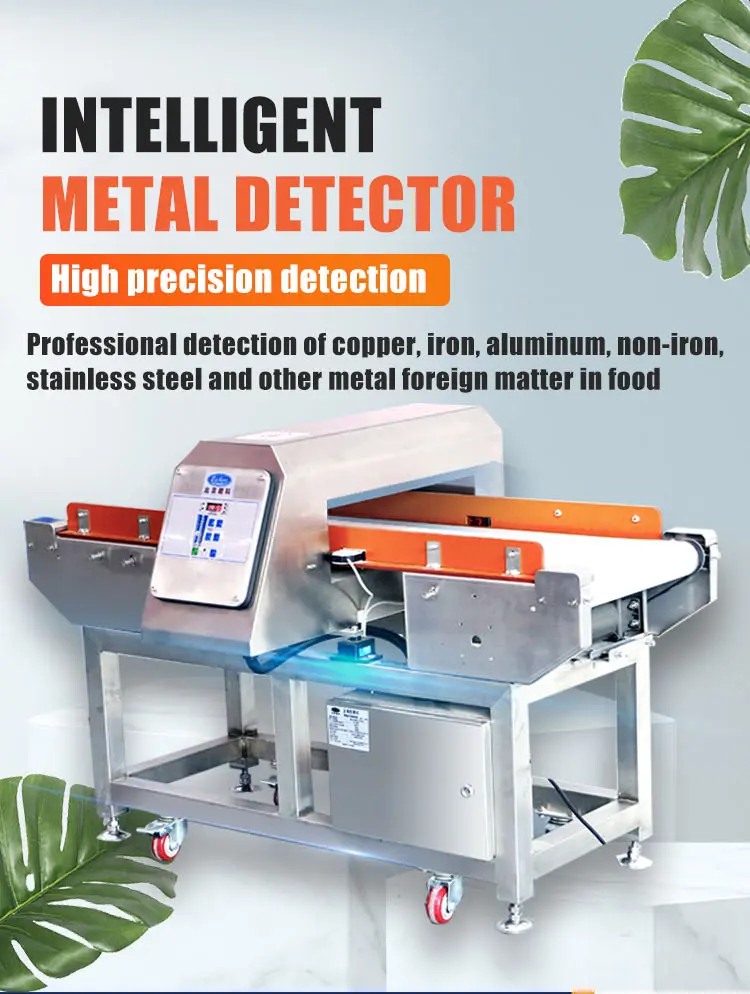
Detection Sensitivity-va
-
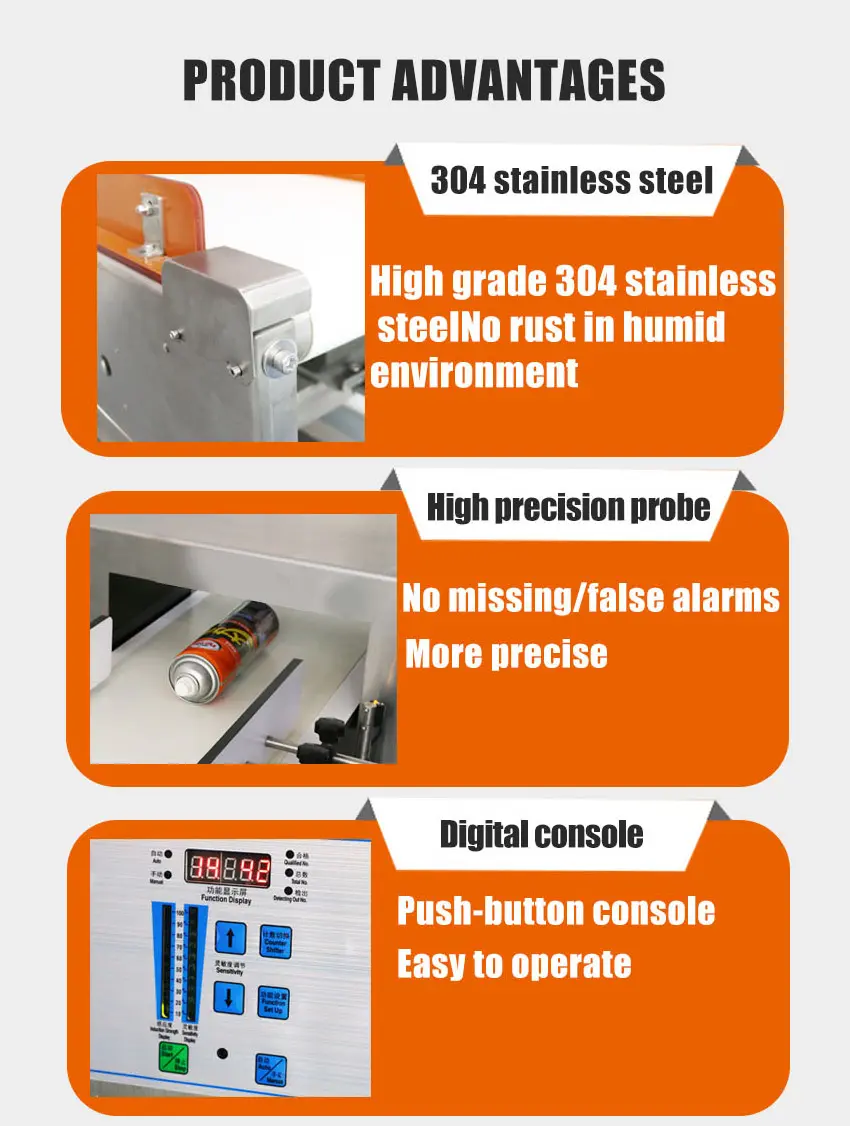
Detection Sensitivity-br
Product Paramenters
| Model | Product Name:Conveyorized Light Metal Detector | |||||||
| BH-WL-918 | ||||||||
| 4010 | 4012 | 4015 | 4020 | 4025 | 4030 | 4035 | ||
| According to the length and width of the conveyor belt, can be customized | ||||||||
| Inspection channel width (mm) | 400 (adjustable width 200-2000) | |||||||
| Inspection channel height(≥0mm) | Inspection window height of conventional machine | Non-standard customized inspection window width | ||||||
| 80 | 120 | 150 | 180 | 200 | 250 | 300 | ||
| Sensitivity | Iron ball Fe diameter (≥φmm) | 0.5 | 0.6 | 0.7 | 0.8 | 1.0 | 1.2 | 1.5 |
| Stainless steel diameter (>φmm) | 1.2 | 1.5 | 1.5 | 2.0 | 2.0 | 2.5 | 3.0 | |
| Body Material | The whole machine is made of 304 stainless steel cold drawn technology | |||||||
| Alarm Mode | Detecting the foreign matter, automatic shutdown, and output 12V buzzer alarm tone (can be customized to a variety of rejection device) | |||||||
| Machine Size | ≈L:1500 x W:920 x H:1010, please refer to the actual product for customized size | |||||||
| Machine weight | ≈200kg | |||||||
| Power supply | Power: 220V 50Hz Power: 120W | |||||||
| Load Capacity | ≤20kg Speed: 25~30m/min(not adjustable) | |||||||
| Working table surface | High:700mm(adjustable height) | |||||||

